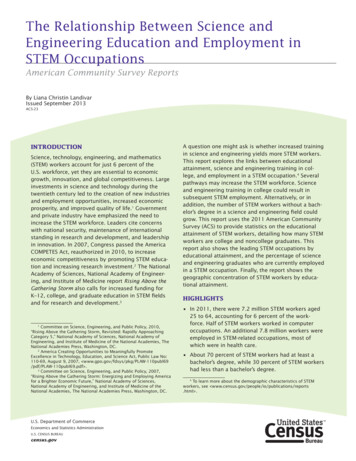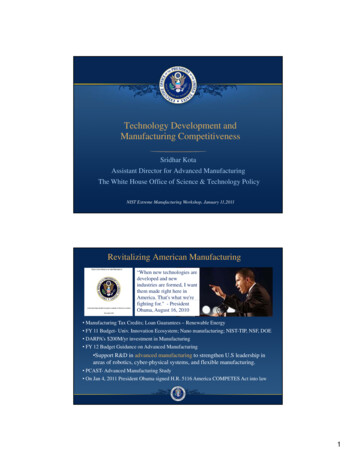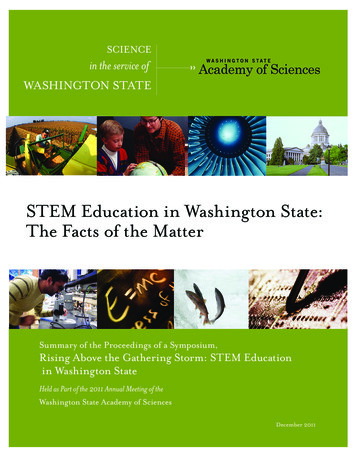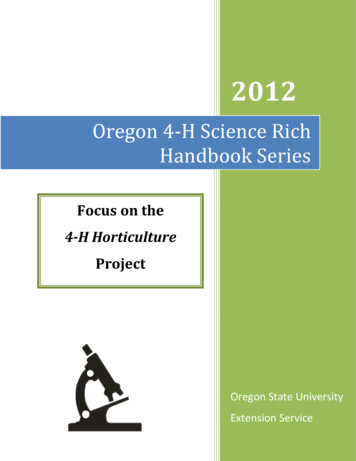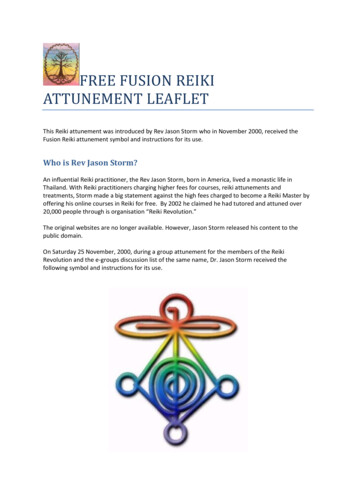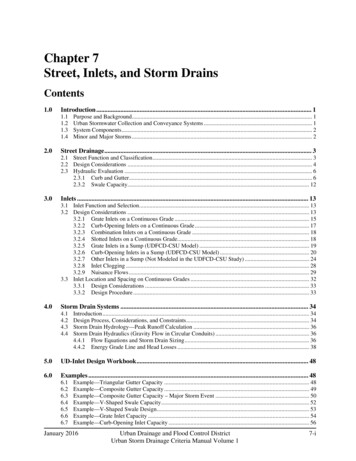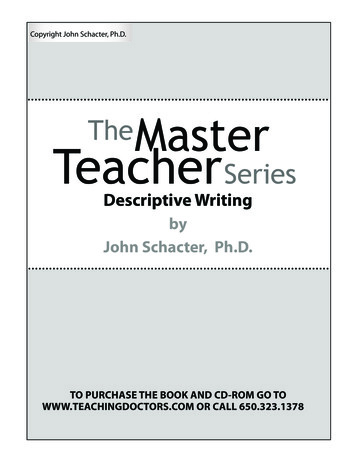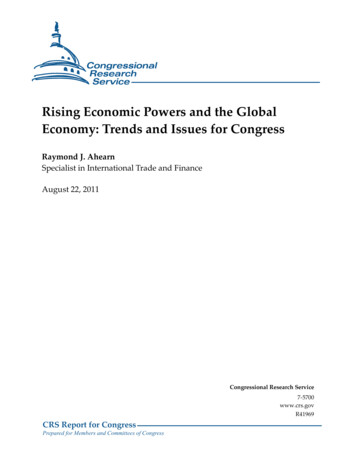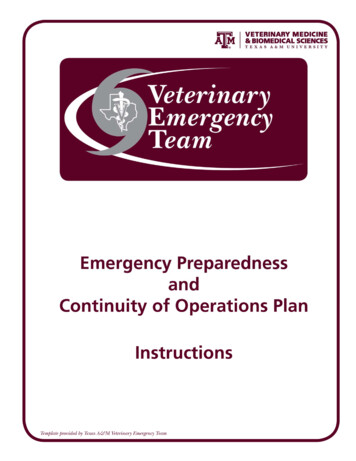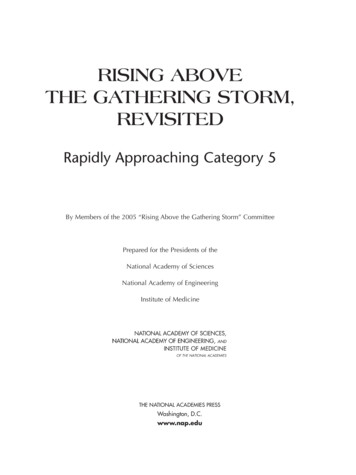
Transcription
RISING ABOVETHE GATHERING STORM,REVISITEDRapidly Approaching Category 5By Members of the 2005 “Rising Above the Gathering Storm” CommitteePrepared for the Presidents of theNational Academy of SciencesNational Academy of EngineeringInstitute of MedicineTHE NATIONAL ACADEMIES PRESSWashington, D.C.www.nap.edu
THE NATIONAL ACADEMIES PRESS 500 Fifth Street, N.W. Washington, DC 20001Support for this project was provided by the National Academy of Sciences, the NationalAcademy of Engineering, and the Institute of Medicine. Any opinions, findings, conclusions, or recommendations expressed in this publication are those of the author(s) and donot necessarily reflect the views of the organizations or agencies that provided supportfor the 8-0-309-16097-1 (Book)0-309-16097-9 (Book)978-0-309-16098-8 (PDF)0-309-16098-7 (PDF)Additional copies of this report are available from the National Academies Press, 500 FifthStreet, N.W., Lockbox 285, Washington, DC 20055; (800) 624-6242 or (202) 334-3313(in the Washington metropolitan area); Internet, http://www.nap.eduCopyright 2010 by the National Academy of Sciences. All rights reserved.Printed in the United States of America
The National Academy of Sciences is a private, nonprofit, self-perpetuating society ofdistinguished scholars engaged in scientific and engineering research, dedicated to thefurtherance of science and technology and to their use for the general welfare. Upon theauthority of the charter granted to it by the Congress in 1863, the Academy has a mandatethat requires it to advise the federal government on scientific and technical matters. Dr.Ralph J. Cicerone is president of the National Academy of Sciences.The National Academy of Engineering was established in 1964, under the charter of theNational Academy of Sciences, as a parallel organization of outstanding engineers. It isautonomous in its administration and in the selection of its members, sharing with theNational Academy of Sciences the responsibility for advising the federal government. TheNational Academy of Engineering also sponsors engineering programs aimed at meeting national needs, encourages education and research, and recognizes the superiorachievements of engineers. Dr. Charles M. Vest is president of the National Academy ofEngineering.The Institute of Medicine was established in 1970 by the National Academy of Sciencesto secure the services of eminent members of appropriate professions in the examination of policy matters pertaining to the health of the public. The Institute acts under theresponsibility given to the National Academy of Sciences by its congressional charter tobe an adviser to the federal government and, upon its own initiative, to identify issues ofmedical care, research, and education. Dr. Harvey V. Fineberg is president of the Instituteof Medicine.The National Research Council was organized by the National Academy of Sciences in1916 to associate the broad community of science and technology with the Academy’spurposes of furthering knowledge and advising the federal government. Functioning inaccordance with general policies determined by the Academy, the Council has becomethe principal operating agency of both the National Academy of Sciences and the NationalAcademy of Engineering in providing services to the government, the public, and thescientific and engineering communities. The Council is administered jointly by bothAcademies and the Institute of Medicine. Dr. Ralph J. Cicerone and Dr. Charles M. Vestare chair and vice chair, respectively, of the National Research Council.www.national-academies.org
2005 “Rising Above the Gathering Storm” CommitteeMembers Participating in“The Gathering Storm, Revisited” NORMAN R. AUGUSTINE [NAE/NAS] (Chair) is the retired chair man and CEO of theLockheed Martin Corporation and a former Undersecretary of the Army. He is arecipient of the National Medal of Technology.CRAIG BARRETT [NAE] is retired chairman and CEO of Intel Corporation.GAIL CASSELL [IOM] is vice president for scientific affairs and a Distinguished LillyResearch Scholar for Infectious Diseases at Eli Lilly and Company. She is the formerpresident of the American Society for Microbiology and former member of the Foodand Drug Administration Science Board and Advisory Committees to the Director ofthe National Institutes of Health and the Center for Disease Control.NANCY GRASMICK is the Maryland state superintendent of schools.CHARLES HOLLIDAY JR. [NAE] is the retired chairman of the Board and CEO ofDuPont.SHIRLEY ANN JACKSON [NAE] is president of Rensselaer Polytechnic Institute. She is apast president of the American Association for the Advancement of Science and waschairman of the U.S. Nuclear Regulatory Commission.ANITA K. JONES [NAE] is University Professor Emerita at the University of Virginia. Sheserved as director of defense research and engi neering at the U.S. Department ofDefense and was vice-chair of the National Science Board.RICHARD LEVIN is president of Yale University and the Frederick William BeineckeProfessor of Economics.C. D. (DAN) MOTE JR. [NAE] is president emeritus of the University of Maryland andthe Glenn L. Martin Institute Professor of Engineering.Additional members of the 2005 Committee:STEVEN CHU [NAS], a Nobel Laureate in physics, is currently serving as U.S. Secretary of Energy.ROBERT GATES, former president of Texas A&M University, is currently serving as U.S. Secretary ofDefense.JOSHUA LEDERBERG [NAS], recipient of the Nobel Prize in physiology/medicine, passed away on February2, 2008. iv
CHERRY MURRAY [NAS/NAE] is dean of the School of Engineering and AppliedScience at Harvard University. She is immediate past president of the AmericanPhysical Society and a past deputy director for sci ence and technology at LawrenceLivermore National Laboratory. She was formerly a senior vice president at BellLabs, Lucent Technologies.PETER O’DONNELL JR. is president of the O’Donnell Foundation of Dallas, a privatefoundation that develops and funds model programs designed to strengthenengineering and science education and research.LEE R. RAYMOND [NAE] is the retired chairman of the Board and CEO of Exxon MobilCorporation.ROBERT C. RICHARDSON [NAS] is the F. R. Newman Professor of Physics and the viceprovost for research at Cornell University. He was a co-winner of the Nobel Prize inphysics in 1996.P. ROY VAGELOS [NAS/IOM] is the retired chairman and CEO of Merck & Co., Inc.CHARLES M. VEST [NAE] is president of the National Academy of Engineering andis president emeritus of MIT and a professor of mechanical engineering. He is arecipient of the National Medal of Technology.GEORGE M. WHITESIDES [NAS/NAE] is the Woodford L. & Ann A. Flowers UniversityProfessor at Harvard University. He has served as an adviser for the NationalScience Foundation and the Defense Advanced Research Projects Agency.RICHARD N. ZARE [NAS] is the Marguerite Blake Wilbur Professor of Natural Scienceat Stanford University. He was chair of the National Science Board from 1996 to1998.
“Gentlemen, we have run out of money. It is time to start thinking.”Sir Ernest Rutherford, Nobel Laureate (Physics)
ForewordWe are pleased to present this report authored by members of the committee that produced the 2005 report, Rising Above the Gathering Storm: Energizing and EmployingAmerica for a Brighter Economic Future. We requested this new report to get the perspective of the original committee on progress and change since the 2005 report.BackgroundRising Above the Gathering Storm was prepared in response to a request by a bipartisan group of Senators and Members of Congress who asked the National Academies torespond to the following questions:What are the top 10 actions, in priority order, that federal policymakers couldtake to enhance the science and technology enterprise so that the United Statescan successfully compete, prosper, and be secure in the global community of the21st century? What strategy, with several concrete steps, could be used to implement each of those actions? These questions were posed in the context of rapid and deep changes in the globaleconomy, investment patterns, advancing science and technology, and the global redistribution of skilled workforces, education, and innovation-driven industries. Moreover, therewas widespread unease about long-term trends in U.S. investments in research, develop- NAS/NAE/IOM, Rising above the Gathering Storm: Energizing and Employing America for a Brighter Economic Future, National Academies Press, 2007. The initial report release was in 2005, with the final, editedbook issued in 2007. Letters from Senators Jeff Bingaman and Lamar Alexander, dated May 27, 2005, and Congressmen SherwoodBoehlert and Bart Gordon, to NAS President Bruce Alberts.ix
prefacement and higher education, and special and deepening concern about the competitiveness of U.S. businesses and the state of the primary and secondary education attained byvast numbers of our children. Rising Above the Gathering Storm was drafted by a group of20 distinguished Americans including then current or former corporate CEOs; universitypresidents; scientists, including three Nobel Laureates; philanthropists, former government officials; and education leaders. Norman R. Augustine, retired CEO of LockheedMartin and former Under Secretary of the Army, chaired the committee. A vast relevantliterature was reviewed, updated, and summarized; a diverse group of 66 stakeholderswas convened to help frame and contextualize the issues; and the committee formedconsensus on its recommendations. Peers drawn from many relevant backgrounds andexperiences reviewed the report prior to its release.The original report informed the debate in Congress and within two presidentialadministrations, and, together with other reviews of America’s competitive position andinnovation environment, led to the passage with strong bipartisan support of the AmericaCOMPETES Act of 2007 that has formed the basis for debating and structuring federalpolicy and budgets, and prompted a great deal of activity at local, state, and regionallevels as well.The Current ReviewIn the five years that have passed since Rising Above the Gathering Storm was issued,much has changed in our nation and world. Despite the many positive responses tothe initial report, including congressional hearings and legislative proposals, America’scompetitive position in the world now faces even greater challenges, exacerbated by theeconomic turmoil of the last few years and by the rapid and persistent worldwide advanceof education, knowledge, innovation, investment, and industrial infrastructure. Indeedthe governments of many other countries in Europe and Asia have themselves acknowledged and aggressively pursued many of the key recommendations of Rising Above theGathering Storm, often more vigorously than has the U.S. We also sense that in the faceof so many other daunting near-term challenges, U.S. government and industry are lettingthe crucial strategic issues of U.S. competitiveness slip below the surface. The Committee on Prospering in the Global Economy of the 21st Century: An Agenda for American Scienceand Technology was authorized under the auspices of the NAS/NAE/IOM Committee on Science, Engineering,and Public Policy (COSEPUP). Its overall charge was to address cross-cutting issues in science and technologypolicy that affect the health of the national research enterprise. America Creating Opportunities to Meaningfully Promote Excellence in Technology, Education, and ScienceAct, Public Law 110-69, August 9, 2007.
prefaceFor these reasons, we believed that the nation would be well served by an update ofthe global context and events since the original report. We therefore asked Mr. Augustine,assisted by National Academies staff, to prepare a first draft of this update document andthen work with the available members of the original committee to refine it. Each of theavailable members of the committee generously agreed to do so as a matter of nationalservice. The resulting report was then anonymously peer reviewed by ten individualswith a wide range relevant expertise and experience. The results of this process arereported herein and have the unanimous support of the available members of the 2005committee. As presidents of the National Academy of Sciences, National Academy of Engineering,and Institute of Medicine, we are pleased to convey this report to interested readers. Webelieve that it will serve to inform the public and policy makers, rekindle and advancean urgent national dialogue, and stimulate further strong and sustained bipartisan effortto ensure the future competitiveness, innovation capacity, economic vitality, and job creation in the opening decades of this century.Ralph J. CiceronePresident, NationalAcademy of SciencesCharles M. VestPresident, NationalAcademy of EngineeringHarvey V. FinebergPresident, Instituteof Medicine One member, Joshua Lederberg, is now deceased. Steven Chu is currently serving as U.S. Secretary of Energyand Robert Gates is currently serving as U.S. Secretary of Defense and therefore they could not participate.xi
PREFACEDuring the summer of 2005, the National Academy of Sciences, the National Academy ofEngineering and the Institute of Medicine undertook a study of America’s evolving competitiveness in the global economy. The study resulted in a 500-page volume that becameknown as the “Gathering Storm” report. It focused upon the ability of Americans to compete for employment in a job market that increasingly knows no geographic boundaries.The Executive Summary of the original report began, “The United States takes deservedpride in the vitality of its economy, which forms the foundation of our high quality of life,our national security, and our hope that our children and grandchildren will inherit evergreater opportunities.” But the report concluded that, “Without a renewed effort to bolsterthe foundations of our competitiveness, we can expect to lose our privileged position.”Contained in the initial report were twenty specific actions that were intended to helpassure that America could in fact remain competitive.Five years have passed since the initial report was prepared, a period in which a greatdeal has changed and a great deal has not changed. The recommendations includedseveral actions that relate specifically to the physical sciences and engineering. Reflectingevolving federal budget priorities, the present report also briefly considers the biologicalsciences, which after a period of growth have begun to see their funding erode. This document, unanimously approved by participating members of the original Gathering Stormcommittee, revisits and updates the earlier findings.xiii
CONTENTSExecutive Summary11.0The Gathering Storm, Revisited162.0Efforts to Avert the Storm243.0Changing Circumstances334.0The Ingredients of Innovation435.04.1Knowledge Capital, 444.2Human Capital, 474.3Environment, 54A Category 5 Storm63AppendixesASome Perspectives69BReport Reviewers81CProject Staff82DBibliography83xv
Executive SummaryIn 2005, bipartisan requests from the United States House of Representatives andthe United States Senate prompted the National Academies to conduct a study ofAmerica’s competitiveness in the newly evolved global marketplace. An Academiescommittee comprised of twenty individuals of highly diverse professional backgrounds, supported by the staff of the Academies and many others, subsequentlyconducted a review of America’s competitive position and released a report that hasbecome popularly referred to as the “Gathering Storm” report after the first line inits title.The Academies’ review culminated in four overarching recommendations, underpinned by twenty specific implementing actions. Generally strong bipartisan supportwas granted these findings on Capitol Hill and in the White House and a numberof the recommendations were eventually implemented. However, the preponderance of the enabling financial resources was provided in the American Recoveryand Reinvestment Act (“Stimulus Legislation”) which is presumed to be a one-time,albeit two-year, initiative. Similarly, the Authorizing Legislation to implement manyof the Gathering Storm recommendations, known as the America COMPETES Act,was specified to expire after three years; i.e., in the 2010 fiscal year.Although significant progress has been made as a result of the above legislation, the Gathering Storm effort once again finds itself at a tipping point. It is widelyagreed that addressing America’s competitiveness challenge is an undertaking thatwill require many years if not decades; however, the requisite federal funding ofmuch of that effort is about to terminate. In order to sustain the progress that hasbegun it will be necessary to (1) reauthorize the America COMPETES Act, and (2)“institutionalize” funding and oversight of the Gathering Storm recommendations—
RISING ABOVE THE GATHERING STORM, REVISITEDor others that accomplish the same purpose—such that funding and policy changeswill routinely be considered in future years’ legislative processes.It would be impossible not to recognize the great difficulty of carrying out theGathering Storm recommendations, such as doubling the research budget, in today’sfiscal environment with worthy demand after worthy demand confronting budgetary realities. However, it is emphasized that actions such as doubling the researchbudget are investments that will need to be made if the nation is to maintain theeconomic strength to provide for its citizens healthcare, social security, nationalsecurity, and more. One seemingly relevant analogy is that a non-solution to makingan over-weight aircraft flight-worthy is to remove an engine.The original Gathering Storm competitiveness report focuses on the ability ofAmerica and Americans to compete for jobs in the evolving global economy. Thepossession of quality jobs is the foundation of a high quality life for the nation’scitizenry.The report paints a daunting outlook for America if it were to continue onthe perilous path it has been following in recent decades with regard to sustainedcompetitiveness.The purpose of the present report is to assess changes in America’s competitive posture in the five years that have elapsed since the Gathering Storm reportwas initially published and to assess the status of implementation of the NationalAcademies’ recommendations.Robert Solow received a Nobel Prize in economics in part for his work thatindicated that well over half of the growth in United States output per hour during the first half of the twentieth century could be attributed to advancements inknowledge, particularly technology. This period was, of course, before the technology explosion that has been witnessed in recent decades. The National AcademiesGathering Storm committee concluded that a primary driver of the future economyand concomitant creation of jobs will be innovation, largely derived from advancesin science and engineering. While only four percent of the nation’s work force is R.M. Solow, “Technical Change and the Aggregate Production Function.” Review of Economics andStatistics, 39: 312-320, 1957.
executive summarycomposed of scientists and engineers, this group disproportionately creates jobs forthe other 96 percent. When scientists discovered how to decipher the human genome it openedentire new opportunities in many fields including medicine. Similarly, when scientists and engineers discovered how to increase the capacity of integrated circuits bya factor of one million as they have in the past forty years, it enabled entrepreneursto replace tape recorders with iPods, maps with GPS, pay phones with cell phones,two-dimensional X-rays with three-dimensional CT scans, paperbacks with electronic books, slide rules with computers, and much, much more. Further, the paceof creation of new knowledge appears by almost all measures to be accelerating. Importantly, leverage is at work here. It is not simply the scientist, engineer andentrepreneur who benefit from progress in the laboratory or design center; it is alsothe factory worker who builds items such as those cited above, the advertiser whopromotes them, the truck driver who delivers them, the salesperson who sells them,and the maintenance person who repairs them—not to mention the benefits realizedby the user. Further, each job directly created in the chain of manufacturing activity generates, on average, another 2.5 jobs in such unrelated endeavors as operating restaurants, grocery stores, barber shops, filling stations and banks. Progressenabling products such as those mentioned above in the information fields is builtupon the work of a few individuals who decades ago were investigating somethingcalled solid state physics—none of whom probably ever thought about CT scans,GPS or iPods—the latter of which can enable one to hold 160,000 books in one’spocket—any more than one today can predict the breakthroughs a half centuryhence. National Science Board, Science and Engineering Indicators 2010. Arlington, VA: National ScienceFoundation (NSB 10-01), Figure 3-3. In 1971, the Intel 4004 Processor had 2300 transistors. See: ores law 40th/MLTimeline.pdf. In 2009, Intel released the Xeon ‘Nehalem-EX’ Processorwith 2.3 billion transistors. See: 09/20090526comp.htm. Beyond Discovery: The Path from Discovery to Human Benefit is a series of articles that explore theorigins of various technological and medical advances (www.beyonddiscovery.org/). J. Bivens, Updated Employment Multipliers for the U.S. Economy (2003), Economic Policy InstituteWorking Paper, August 2003. Available at: http://www.epi.org/page/-/old/workingpapers/epi wp 268.pdf. For a 64 gigabyte iPod, holding books with an average file size of 400 kilobytes.
RISING ABOVE THE GATHERING STORM, REVISITEDThe Gathering Storm report assessed America’s position with respect to each ofthe principal ingredients of innovation and competitiveness—Knowledge Capital,Human Capital and the existence of a creative “Ecosystem.” Numerous significantfindings resulted—for example, with regard to Knowledge Capital it was noted thatfederal government funding of R&D as a fraction of GDP has declined by 60 percentin 40 years. With regard to Human Capital, it was observed that over two-thirdsof the engineers who receive PhD’s from United States universities are not UnitedStates citizens. And with regard to the Creative Ecosystem it was found that UnitedStates firms spend over twice as much on litigation as on research. However, themost pervasive concern was considered to be the state of United States K-12 education, which on average is a laggard among industrial economies—while costingmore per student than any other OECD country.10So where does America stand relative to its position of five years ago when theGathering Storm report was prepared? The unanimous view of the committee members participating in the preparation of this report is that our nation’s outlook hasworsened. While progress has been made in certain areas—for example, launchingthe Advanced Research Projects Agency-Energy—the latitude to fix the problemsbeing confronted has been severely diminished by the growth of the national debtover this period from 8 trillion to 13 trillion.11Further, in spite of sometimes heroic efforts and occasional very bright spots,our overall public school system—or more accurately 14,000 systems—has shownlittle sign of improvement, particularly in mathematics and science.12 Finally, manyother nations have been markedly progressing, thereby affecting America’s relativeability to compete effectively for new factories, research laboratories, administrative Federal R&D was 1.92 percent of GDP in 1964 and 0.76 percent of GDP in 2004. See: df. National Science Foundation, Division of Science Resources Statistics, Survey of Earned Doctorates.See f. NSB, 2010, Appendix Tables 4-8 and 4-9; Towers Perrin, 2009 Update on U.S. Tort Cost Trends,Appendixes 1-5.10 NSB, 2010, Appendix Tables 1-9, 1-10, and 1-11; and Organization for Economic Cooperationand Development, Education at a Glance 2009: OECD Indicators; Table B-1. See: http://www.oecd.org/document/24/0,3343,en 2649 39263238 43586328 1 1 1 37455,00.html.11 See Table 7.1, Federal Debt at the End of the Year: 1940:2015 at: http://www.whitehouse.gov/omb/budget/Historicals/ (accessed August 23, 2010).12 National Center for Education Statistics, Numbers and Types of Public Elementary and SecondaryLocal Education Agencies, From the Common Core of Data: School Year 2007–08. See: http://nces.ed.gov/pubs2010/2010306.pdf (accessed August 23, 2010).
executive summarycenters—and jobs. While this progress by other nations is to be both encouragedand welcomed, so too is the notion that Americans wish to continue to be amongthose peoples who do prosper.The only promising avenue for achieving this latter outcome, in the view of theGathering Storm committee and many others, is through innovation. Fortunately,this nation has in the past demonstrated considerable prowess in this regard.Unfortunately, it has increasingly placed shackles on that prowess such that, if notrelieved, the nation’s ability to provide financially and personally rewarding jobsfor its own citizens can be expected to decline at an accelerating pace. The recommendations made five years ago, the highest priority of which was strengtheningthe public school system and investing in basic scientific research, appears to be asappropriate today as then.The Gathering Storm Committee’s overall conclusion is that in spite of the effortsof both those in government and the private sector, the outlook for America to compete for quality jobs has further deteriorated over the past five years.The Gathering Storm increasingly appears to be a Category 5.
RISING ABOVE THE GATHERING STORM, REVISITEDA Few FactoidsThirty years ago, ten percent of California’s general fund went to highereducation and three percent to prisons. Today, nearly eleven percentgoes to prisons and eight percent to higher education.1China is now second in the world in its publication of biomedicalresearch articles, having recently surpassed Japan, the United Kingdom,Germany, Italy, France, Canada and Spain.2The United States now ranks 22nd among the world’s nations in thedensity of broadband Internet penetration and 72nd in the density ofmobile telephony subscriptions.3In 2009, 51 percent of United States patents were awarded to nonUnited States companies.4The World Economic Forum ranks the United States 48th in quality ofmathematics and science education.5Of Wal-Mart’s 6,000 suppliers, 5,000 are in China.6There are sixteen energy companies in the world with larger reservesthan the largest United States company.7IBM’s once promising PC business is now owned by a Chinesecompany.8The legendary Bell Laboratories is now owned by a French company.9Hon Hai Precision Industry Co. (computer manufacturing) employsmore people than the worldwide employment of Apple, Dell, Microsoft,Intel and Sony combined.10No new nuclear plants and no new petroleum refineries have been builtin the United States in a third of a century, a period characterized byintermittent energy-related crises.11Only four of the top ten companies receiving United States patents lastyear were United States companies.12United States consumers spend significantly more on potato chips thanthe government devotes to energy R&D.13
executive summaryThe world’s largest airport is now in China.14In 2000 the number of foreign students studying the physical sciencesand engineering in United States graduate schools for the first timesurpassed the number of United States students.15Federal funding of research in the physical sciences as a fraction of GDPfell by 54 percent in the 25 years after 1970. The decline in engineeringfunding was 51 percent.16GE has now located the majority of its R&D personnel outside theUnited States.17Manufacturing employment in the U.S. computer industry is now lowerthan when the first personal computer was built in 1975.18In the 2009 rankings of the Information Technology and InnovationFoundation the U.S. was in sixth place in global innovation-basedcompetitiveness, but ranked 40th in the rate of change over the pastdecade.19China has now replaced the United States as the world’s number onehigh-technology exporter.20In 1998 China produced about 20,000 research articles, but by 2006the output had reached 83,000 . . . overtaking Japan, Germany and theU.K.21Eight of the ten global companies with the largest R&D budgets haveestablished R&D facilities in China, India or both.22During a recent period during which two high-rise buildings were constructed in Los Angeles, over 5,000 were built in Shanghai.23In a survey of global firms planning to build new R&D facilities, 77 percent say they will build in China or India.24China has a 196 billion positive trade balance. The United States’ balance is negative 379 billion.25Sixty-nine percent of United States public school students in fifththrough eighth grade are taught mathematics by a teacher without adegree or certificate in mathematics.26
RISING ABOVE THE GATHERING STORM, REVISITEDNinety-three percent of United States public school students in fifththrough eighth grade are taught the physical sciences by a teacherwithout a degree or certificate in the physical sciences.27Of the Big Three American automakers, one is now owned by a firm inItaly (after having been previously sold by a German firm),
2005 “RISINg AbOvE THE gATHERINg STORM” COMMITTEE MEMbERS PARTICIPATINg IN “THE gATHERINg STORM, REvISITED”1 NORMAN R. AUgUSTINE [NAE/NAS] (Chair) is the retired chairman and CEO of the Lockheed Martin Corporation and a former Undersecretary of the Arm
